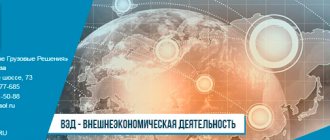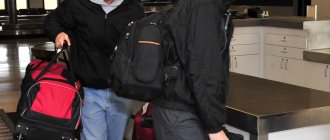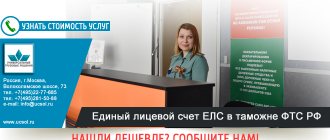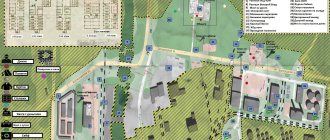02/12/2019 Customs clearance
Transition to a Unified Personal Account through the eyes of a company providing customs clearance services. What we faced for the period December 2021 - January 2021
A single personal account (hereinafter referred to as UAL) is an account that is kept in Moscow in the Federal Treasury. It unites all personal accounts of foreign trade participants, which are opened at all customs points in Russia. The funds that the foreign trade participant pays for customs payments: duties, advance payments, fines, penalties - are automatically transferred to this unified tax system. From it, the foreign trade participant pays payments to any customs office, regardless of where his cargo arrives and where it is submitted for customs clearance.
The distribution of funds for advances, duties, and excise taxes remained with different BCCs, as it was before.
The introduction of the ELS is associated with the process of merging the Federal Customs Service with the Federal Tax Service. And with the transition in the future to a completely transparent electronic declaration system.
Single personal account - advantages of switching
Previously, funds of foreign trade participants were received and stored in the account of the customs payments department. Now the customs payments department of a particular customs office cannot dispose of these funds at the place of filing the declaration. All money is in the Federal Treasury in Moscow, and the accounts are managed through Moscow. Thus, it has become easier to control the receipt and expenditure of funds automatically. This is a personal account of a foreign trade participant, connected via an electronic digital signature. That is, by logging into his personal account, a participant in foreign economic activity can see how much money he has for the cash advance payment system, for the duty payment committee, and paid fines and penalties for specific payment documents are also reflected there.
We (declarants) can manage funds from the ELS at any customs post, regardless of the arrival of the cargo or the deadline for submission.
We see all the money that is returned after conditional adjustment, after deposits for sampling, after deposits for code, and other deposits throughout Russia. If the decision is made in favor of the foreign trade participant, the money must be returned to them. Moreover, when the return document is being processed, it is decided that if the foreign trade participant has correctly stated all the data, the money will be returned to him automatically within 30 working days WITHOUT APPLICATIONS.
If there were any deposits in the accounts at regional customs over the last 3 years, this money hung, since the process of returning it was quite labor-intensive. A notarized package of documents was required. Now participants in foreign trade activities have begun to receive gifts. All this “frozen” money began to be sent to the ELS automatically for disposal against future customs payments.
If a foreign trade participant has completed his activities and does not intend to pay customs duties in the future, what does he need to do?
Previously, we submitted a package of documents at the location of the personal account, the customs authority reviewed the application, wrote a memo to the Federal Treasury, and the Federal Treasury returned the funds to the client’s account.
Now the return is different. The foreign trade participant will need to apply at the place of tax registration of the legal entity. That is, he needs to submit an application for a refund not at the place of filing the customs declaration, but at the place of registration of the enterprise’s checkpoint with the local tax authority. With a package of documents, the foreign trade participant submits an application for a refund to the customs department at the place of registration.
This is because the accounts are now controlled not by the customs authorities, but by the tax department. After all, we are moving towards a unified electronic information space, where customs and tax authorities work as a single system. Declarants will work online, where they will not need to provide information on paper and will not need to reconcile it. Therefore, the disposal of these funds was transferred specifically to the Federal Tax Service.
In our experience there have been no return precedents. Therefore, we cannot yet say how simply and quickly this procedure occurs. We recommend writing off money towards customs duties at zero. This procedure is carried out upon application and a package of documents at the place of registration of the legal entity.
What is a single personal account of the housing and communal services payer?
ELS was introduced into payment systems by order of the Ministry of Telecom and Mass Communications of the Russian Federation No. 944/pr (December 28, 2015). This is a special code consisting of numbers and letters, a total of 10 characters are used. This code is written in payment documents, which allows you not only to quickly make payments, but also to control accruals and payments for housing and communal services.
It looks like this:
ELS in the housing and communal services receipt.
ELS completely eliminates the possibility of any controversial issues or funds going to the wrong address. Management companies and organizations that supply resources and carry out scheduled and major repairs assign a personal account to the consumer based on the company’s developed algorithms. There are cases of coincidence, which invariably led to errors when making payments. In order to establish uniformity, the GIS ZhKS introduced a single personal account.
To date, more than 200 million single personal accounts have been registered. This has helped bank employees receive all the necessary information for online payments almost instantly. Consumers also benefited significantly. If, for example, you have not received your bills before the due date, you can pay for housing and communal services using the ELS; you do not need to have a receipt with you.
ELS and TC - what you need to know
So, the TC serves to simplify the transfer of funds for customs payments, and the ELS serves to simplify the accounting of these funds. Technologies can be used when working in parallel, but TC is an exclusively voluntary service that requires additional costs and is provided by banking organizations, while ELS is the administration of customs payments by customs authorities and will eventually be used by all participants in foreign trade activities.
Customs card (Plastic card/Remote payment).
First, it is necessary to recall how participants in foreign trade activities deposit funds to pay customs duties without using remote payment and a single personal account.
The standard payment procedure is the transfer of funds to the account of the customs authority with the definition of the account and details of the customs authority (namely the customs office, the customs code is indicated), the purpose of the payment (advance, duty, penalties or other payments) with the corresponding budget classification code (BCC) . When making a payment, the bank generates a payment document (payment order) and the funds arrive at the customs clearance authorities, as a rule, on the same day or the next day, depending on the time the order is transmitted to the bank and the payment is made by the bank (according to the draft federal law, crediting must occur within 4 hours). After these funds are reflected in the customs payment accounting system of the customs authority, they can be used to pay customs duties under a specific customs declaration (CD) or other document (for example, a customs receipt - TR).
It is the payment mechanism that changes when using TC , i.e. A request to the bank for the transfer of funds is carried out through an issued plastic card using the following methods of “remote” payment through:
- specialized terminal at customs clearance points;
- terminal installed in the office;
- Personal Area;
- Internet payment in the electronic declaration program.
In this case, there is an almost instant transfer of funds described in the standard procedure above, but with the same details and payment document it is no longer a payment order, but a check . Depending on the payment method, the following procedures occur: through the payment operator system (Customs Card LLC/Multiservice Payment System LLC (Round)), a request is sent to the bank to write off funds to the account of the customs authorities, the bank identifies the card, holder and the owner of the plastic card, confirms the debit from the bank, after which the operator’s system makes the payment and receives confirmation from the customs authorities about the receipt of funds.
The procedure and procedure for remote payment are described in the Order of the Federal Customs Service of Russia No. 406-r dated December 19, 2013 “On approval of the Temporary procedure for actions of customs officials during remote payment of customs and other payments collected by customs authorities, persons declaring goods in electronic form, with using an electronic terminal."
The most attractive payment method today is to combine payment through your personal account and online payment in the declaration program. According to the procedure mentioned above, payments in this case are made in two stages - after opening the declaration procedure, customs duties are transferred, after registration of the customs declaration, payments in respect of duties, VAT and other payments are transferred. It should be noted that the definition of payment stages is not technically mandatory and payments can be transferred in full at the stage of opening the declaration procedure. All transferred funds have unique payment document details and are identified by the payer’s details, the number and date of the check, as well as other details characteristic of standard payment orders. If the transferred funds are not used to pay customs duties for a specific declaration, they can be used to pay another declaration as a regular payment document, taking into account the coincidence in these declarations of the declarant, the customs office of filing and the purpose of payment (i.e. VAT is paid with KBK advance payments, and duties from payments to KBK duties), also these payments can be returned according to the standard return procedure. This is where the Unified Personal Account , which allows you to use the transferred funds at any customs office, which adds flexibility in the use of funds when changing the customs clearance authority to the speed of payment.
To make online payments, it is necessary to obtain and “link” the electronic signature (ES) of the cardholder to the issued card through a request to the bank; a prerequisite for the ES used for payment is double compliance, which is reflected in the fact that the data of an individual and a legal entity in the electronic signature must exactly match the data on the issued plastic card. Administering electronic signatures with cards requires additional time, because the card and electronic signature have an expiration date and after a certain period they must be reissued and re-linked, as well as monitoring relationships with authorized persons - cardholders. To simplify this procedure, as well as simplify payment from customs cards by customs representatives, payment work is being carried out without the need to issue an electronic signature with double identification, which will allow the use of trusted electronic signatures of customs representative employees, which are used for electronic declaration (the service is provided by the “Customs Card” jointly with Sberbank).
To start using a customs card, you need to contact your bank and familiarize yourself with the terms of issue and use; the cost of use can be calculated from the amounts of transferred payments.
Single personal account (Payment to the Federal Customs Service level).
Payment to a Unified Personal Account differs from the standard payment procedure described above only in that advance and specific payments are made not to the account of a separate customs authority (customs), but to a single account using the code “10000010”, which allows you to use the transferred funds at any customs office ( This also applies to the return procedure, which under the ELS can be carried out by any customs office or GUFTTDiTR FCS). Those. types of BCC and other characteristics are preserved, only the code of the customs authority is changed, this makes it possible to simplify the administration of payments to both foreign trade participants and customs authorities.
The use of ELS is legislatively enshrined in Order of the Federal Customs Service of Russia No. 1407 dated July 30, 2013 “On approval of the Concept of centralization of accounting for customs and other payments and maintaining a single personal account of a participant in foreign economic activity” and Order of the Federal Customs Service of Russia No. 1617 dated August 22, 2016 “On approval of the Temporary Procedure for the work of interested structural divisions of the Federal Customs Service of Russia, the Central Information and Technical Customs Administration and customs offices with a single resource of personal accounts of payers of customs duties and taxes opened at the level of the Federal Customs Service of Russia.”
Details about the procedure and forms of documents when opening a Single Personal Account are given in the memo for participants in foreign economic activity (open in Pdf).
To open an ELS you must:
- Submit an application for opening an ELS by e-mail: [email protected] /fax with mandatory delivery by mail (121087, Moscow, Novozavodskaya St., 11/5) and agree on the opening date of the ELS;
- Carry out the procedure for offsetting funds (which were previously transferred to customs accounts): reconcile payment balances at all customs offices, write an application for offset;
- Adjust the payment details from the date of opening the ELS (to the account of the customs authority using code (field 107) 10000010, as indicated in the sample payment order);
- Wait for the balance to be transferred to the ELS.
If necessary, scanned copies of applications are sent electronically to the post office of the customs authorities (customs offices), where customs clearance is carried out.
All participants in foreign trade activities will eventually switch to using the ELS.
The FCS service “Personal Account Information”, if there is an electronic signature of a foreign trade participant, allows you to obtain information:
- about balances on payment documents,
- on the expenditure of funds contributed as advance payments,
- on confirmation of payment of customs duties and taxes.
The request is carried out for each customs office separately when filling out an electronic application; to obtain information on the Unified Customs Service, you need to indicate the code “10000010” instead of the customs code.
This information is for reference only, but allows you to quickly check balances, control the receipt of funds (personal account balances), avoid manual accounting of customs payments, or set up an automatic check in the accounting system based on a report on the expenditure of funds. Using a personal account provided by a payment operator (using a customs card) provides additional administration options.
At the same time, an official document in paper form on the expenditure of funds can be obtained exclusively according to the standard procedure within 30 days (this period has been reduced to 20 calendar days according to the draft federal law “On Customs Regulation in the Russian Federation”).
Trans-Business Broker, as a customs representative, works with all methods of paying customs duties, has practical experience in Internet payments in the process of electronic declaration, through a personal account and through payment terminals using both its own customs card and clients’ customs cards. We recommend our clients to switch to ELS, because... We ourselves plan to do this in the near future, in turn, such a transition will make it impossible to pay payments at the expense of clients who have not switched to ELS. Using a customs card as a tool for prompt payment of unplanned payments is also useful, but is more expensive compared to payment by payment order.
prev
track.
How to find out the ELS for paying utility bills?
Each citizen can very quickly find out his single personal account. To do this, you need to go to the portal GIS Housing and Communal Services (State Information System of Housing and Communal Services) my.dom.gosuslugi.ru.
You need to log into the site and go through authorization. After passing, you will be able to log into your personal account and follow the “Connected personal accounts” link. Your accounts will appear at the bottom of the screen. Here, a single personal account will be indicated in a separate column. If the owner does not yet have a personal account, it can be connected. To do this you need to enter the following data:
- house address;
- indicate the apartment;
- The room number is indicated if a room is rented, for example, in a dormitory;
- any available payer identifier.
The facial code is generated automatically based on the information provided by the consumer. The encoding of a single personal account is as follows: the first digit is the designation of the control row, the second to tenth is the directly unique ULS number.
ELS is what helps a financial organization that accepts payments for utilities, contributions for repairs, pays fines and penalties, pays expenses for the maintenance of common property, etc., to identify the making of any of these payments as those related to housing and communal services. Information about payment is immediately transmitted to the Housing Information System.
Problems associated with switching to ELS from a regular account
If a participant in foreign economic activity was transferred to the unified tax system at the time of filling out the customs declaration, then column 47 in this case should be filled out differently. The inspector cannot make changes to the part of the declaration relating to money. And very often we, as declarants, have to go through recall or refusal. It turns out that the client has money in his account. When it was submitted, I sent money to a specific account of the regional customs authority, but by the time of release, literally within a day, it was transferred to the ELS, and customs cannot write off this money. More precisely, there are customs offices that have learned to do this, and there are customs offices that accept the declaration only through its reissue. In this case, we withdraw the declaration, fill it out taking into account the requirements of the ELS, lose the fees, and only after that the money is written off.
Payment for housing and communal services using ELS
A single personal account allows you to pay for utilities in one click, without fees, queues and wasting personal time. Nowadays you rarely meet a person who does not have a bank card, and any reputable financial institution has a mobile application where you can register, make transfers between accounts, pay for purchases, services, including housing and communal services bills.
We have already looked at how to find out the ESL to pay for utilities. This is what you need to indicate, and then pay the bill quickly and conveniently. Also, many banks offer to enable an alert function. Here you will also need an ELS, which is entered in the “housing and communal services accruals” section. Each new accrual will come with a notification. Accruals are made automatically and displayed in the application on the main page.
The payment receipt can be sent by email or printed. If you urgently need a document and you cannot find it, you can look at the payment in the “made payments” section or request a copy.
How to pay for housing and communal services using ELS through State Services?
Many Russian citizens have long been using the State Services portal to pay utility bills. When entering the site, you must enter an ELS and a secret password (it cannot be shared with strangers).
On the site you can not only pay bills, but also carry out a number of other operations:
- find out when the deadline comes to transfer the IPU indicators. This must be done monthly from the 15th of the current month to the third of the next. If you submit meter readings later, the readings will be taken into account only after a month;
- Payments must be made by the 10th of the current month. Exceptions apply only to receipts that come under contracts that indicate a different payment interval;
- property owners can control the amount of charges and monitor changes in tariffs. The list of mandatory services has two main categories: housing and utilities. Utilities include payment for consumed resources (cold and hot water, electricity, gas, sewerage, heat). Housing – this includes maintenance, current and major repairs of residential and common premises, removal of solid waste, intercom, television antenna, etc.
Also, with the help of a single personal account of the housing and communal services payer, the owner can find out about the required benefits or subsidies.
It is very important to always pay for housing and communal services on time, because failure to pay can lead to the imposition of penalties, disconnection of an apartment or house from the distribution network, as well as debt collection through the court.






